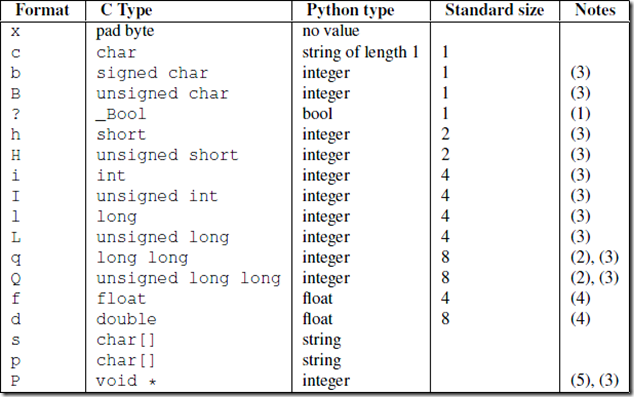python模塊之subprocess模塊, struct模塊
阿新 • • 發佈:2017-09-26
ber recv blog tdi pre grep 3.2 hid lin

subprocess
import subprocess ‘‘‘ sh-3.2# ls /Users/egon/Desktop |grep txt$ mysql.txt tt.txt 事物.txt ‘‘‘ res1=subprocess.Popen(‘ls /Users/jieli/Desktop‘,shell=True,stdout=subprocess.PIPE) res=subprocess.Popen(‘grep txt$‘,shell=True,stdin=res1.stdout, stdout=subprocess.PIPE)print(res.stdout.read().decode(‘utf-8‘)) #等同於上面,但是上面的優勢在於,一個數據流可以和另外一個數據流交互,可以通過爬蟲得到結果然後交給grep res1=subprocess.Popen(‘ls /Users/jieli/Desktop |grep txt$‘,shell=True,stdout=subprocess.PIPE) print(res1.stdout.read().decode(‘utf-8‘)) #windows下: # dir | findstr ‘test*‘ # dir | findstr ‘txt$‘ importsubprocess res1=subprocess.Popen(r‘dir C:\Users\Administrator\PycharmProjects\test\函數備課‘,shell=True,stdout=subprocess.PIPE) res=subprocess.Popen(‘findstr test*‘,shell=True,stdin=res1.stdout, stdout=subprocess.PIPE) print(res.stdout.read().decode(‘gbk‘)) #subprocess使用當前系統默認編碼,得到結果為bytes類型,在windows下需要用gbk解碼
struct
struct模塊
該模塊可以把一個類型,如數字,轉成固定長度的bytes
>>> struct.pack(‘i‘, 1000000000000000000) Traceback (most recent call last): File "<stdin>", line 1, in <module> struct.error: argument out of range # struct.error: ‘i‘ format requires -2147483648 <= number <= 2147483647 #這個是範圍

import json,struct #假設通過客戶端上傳1T:1073741824000的文件a.txt #為避免粘包,必須自定制報頭 header={‘file_size‘:1073741824000,‘file_name‘:‘/a/b/c/d/e/a.txt‘,‘md5‘:‘8f6fbf8347faa4924a76856701edb0f3‘} #1T數據,文件路徑和md5值 #為了該報頭能傳送,需要序列化並且轉為bytes head_bytes=bytes(json.dumps(header),encoding=‘utf-8‘) #序列化並轉成bytes,用於傳輸 #為了讓客戶端知道報頭的長度,用struck將報頭長度這個數字轉成固定長度:4個字節 head_len_bytes=struct.pack(‘i‘,len(head_bytes)) #這4個字節裏只包含了一個數字,該數字是報頭的長度 #客戶端開始發送 conn.send(head_len_bytes) #先發報頭的長度,4個bytes conn.send(head_bytes) #再發報頭的字節格式 conn.sendall(文件內容) #然後發真實內容的字節格式 #服務端開始接收 head_len_bytes=s.recv(4) #先收報頭4個bytes,得到報頭長度的字節格式 x=struct.unpack(‘i‘,head_len_bytes)[0] #提取報頭的長度 head_bytes=s.recv(x) #按照報頭長度x,收取報頭的bytes格式 header=json.loads(json.dumps(header)) #提取報頭 #最後根據報頭的內容提取真實的數據,比如 real_data_len=s.recv(header[‘file_size‘]) s.recv(real_data_len)

#_*_coding:utf-8_*_ #http://www.cnblogs.com/coser/archive/2011/12/17/2291160.html __author__ = ‘Linhaifeng‘ import struct import binascii import ctypes values1 = (1, ‘abc‘.encode(‘utf-8‘), 2.7) values2 = (‘defg‘.encode(‘utf-8‘),101) s1 = struct.Struct(‘I3sf‘) s2 = struct.Struct(‘4sI‘) print(s1.size,s2.size) prebuffer=ctypes.create_string_buffer(s1.size+s2.size) print(‘Before : ‘,binascii.hexlify(prebuffer)) # t=binascii.hexlify(‘asdfaf‘.encode(‘utf-8‘)) # print(t) s1.pack_into(prebuffer,0,*values1) s2.pack_into(prebuffer,s1.size,*values2) print(‘After pack‘,binascii.hexlify(prebuffer)) print(s1.unpack_from(prebuffer,0)) print(s2.unpack_from(prebuffer,s1.size)) s3=struct.Struct(‘ii‘) s3.pack_into(prebuffer,0,123,123) print(‘After pack‘,binascii.hexlify(prebuffer)) print(s3.unpack_from(prebuffer,0))struct詳細用法
python模塊之subprocess模塊, struct模塊

